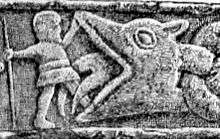Gosforth Cross


The Gosforth Cross is a large stone Anglo-Saxon cross in St Mary's churchyard at Gosforth in the English county of Cumbria. Formerly part of the kingdom of Northumbria, the area was settled by Scandinavians some time in either the 9th or 10th century. The cross itself dates to the first half of the 10th century.
Description
The Gosforth Cross has elaborate carvings which have been interpreted as representing characters and scenes from Norse mythology. The Gosforth Cross was first identified in 1886 by the amateur antiquarian Charles Arundel Parker in his book The Ancient Crosses at Gosford and Cumberland. He demonstrated that the cross showed scenes described in the Poetic Edda.[1] Those include images identified as:
- Loki bound with his wife Sigyn protecting him.
- The god Heimdallr holding his horn.
- The god Víðarr tearing the jaws of Fenrir.
- Thor's failed attempt to catch Jörmungandr, the Midgard Serpent.
The cross also has Christian symbolism, including a depiction of the crucifixion of Christ. The combination of Christian and Norse pagan symbolism on the cross may be evidence of the use of pagan stories to illustrate Christian teachings.[1]
The cross is 4.4 metres tall and made out of red sandstone. It is estimated to date from 920-950 and is still in fairly good condition. The importance of the Gosforth Cross (as well as the Irton Cross) caused the Victoria and Albert Museum to have replicas made in 1882.[2] They are on display in the Cast Hall at the museum. In 1887, the Rev. William Slater Calverley commissioned a replica life-sized copy of this cross and erected it in the churchyard at Aspatria, Cumbria.[3]
The church also has important hogback tombs, and what appears to be a fragment of another cross, showing the god Thor fishing.
Galleries
The following images depict the 10th century Gosforth Cross and related artifacts at St Mary's church in Gosforth in the English county of Cumbria. The region was formerly part of the kingdom of Northumbria, an area settled by Scandinavians in the 9th or 10th century. The images were published by Finnur Jónsson in Goðafræði Norðmanna og Íslendinga eftir Heimildum in 1913. The identifications of the figures are those suggested by Jónsson in 1913.

 The bound Loki
The bound Loki Engraving of Víðarr section of cross.
Engraving of Víðarr section of cross. Engraving of cross showing Fenrir and Heimdallr.
Engraving of cross showing Fenrir and Heimdallr.
Other Images
- View of the Viking Cross and church, from the SE
- The stump of the second cross
 Engraving of a stone panel, possibly part of the second cross, showing Thor fishing.
Engraving of a stone panel, possibly part of the second cross, showing Thor fishing.
Notes
- 1 2 Bailey (1996:86-90).
- ↑ See link to V&A site
- ↑ Calverley and Collingwood (1899), p.139-167
References
- Arundel P Charles, The Ancient crosses at Gosforth and Cumberland, Elliot Stock, 1896
- Bailey, Richard N. (1996). England's Earliest Sculptors. University of Toronto. ISBN 0-88844-905-4.
- Bailey, Richard N. (2002). "Scandinavian Myth on Viking-period Stone Sculpture in England". In Barnes, Geraldine; Ross, Margaret Clunies. Old Norse Myths, Literature, and Society (PDF). Sydney: University of Sydney. pp. 15–23. ISBN 1-86487-316-7.
- Finnur Jónsson (1913). Goðafræði Norðmanna og Íslendinga eftir heimildum. Reykjavík: Hið íslenska bókmentafjelag.
- Rev. William Slater Calverley; W. G. Collingwood M.A. (1899). Notes on the Early Sculptured Crosses, Shrines and Monuments in the Present Diocese of Carlisle. Kendal: Titus Wilson.
External links
| Wikimedia Commons has media related to Gosforth Cross. |
Coordinates: 54°25′10″N 3°25′54″W / 54.41934°N 3.43165°W